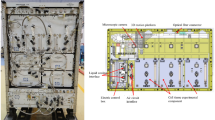Abstract
A compact, flow-through oxygen sensor device based on luminescence quenching was used to monitor dissolved oxygen levels during mammalian cell growth on the STS-93 mission of the Columbia space shuttle. Excitation of an oxygen-sensitive ruthenium complex was provided by a radiolumin escent light source (0.9 mm in diameter, 2.5 mm long), and the intensity of the resulting luminescence was measured by a simple photodiode detector. The use of radiolum inescence for the excitation light source is a unique approach that provides many features important for long-term and remote monitoring applications. For the spaceflight experiment, human lung fibroblast cells (WI-38) were grown in hollow-fiber bioreactors. Oxygen concentration was measured in the flow path both before and after the bioreactor cartridge in order to gain information about the metabolism of the cells. The sensor was found to be nonperturbing to cell growth and withstood the challenging physical conditions of shuttle launch and landing while maintaining a stable calibration function. In addition, the sensor provided physically meaningful oxygen predictions.
Similar content being viewed by others
References
Orna, M. V. (1989), in Elect rochemistry, Past and Present, vol. 390, Stock, J. T. and Orna, M. V., eds., American Chemical Society, Washington, DC, pp. 196–210.
Harris, D. C. (1995), Quantitative Chemical Analysis, W. H. Freeman, New York.
Turner, A. P. F. and White, S. F. (1999), in Encycloped in of Bioprocess Technology: Fermentation, Biocatalysis, and Bioseparation, vol. 4, Flickinger, M. C., and Drew, S. W., eds., Wiley, New York, pp. 2056–2070.
Chuang, H. and Arnold, M. A. (1999), Pure Appl. Chem. 71, 803–810.
Demas, J. N. and DeGraff, B. A. (1991), Anal. Chem. 63, 829A-837A.
Kneas, K. A., Demas, J. N., DeGraff, B. A., and Periasamy, A. (2000), Microsc. Microanal. 6, 551–561.
Demas, J. N., DeGraff, B. A., and Coleman, P. B. (1999), Anal. Chem. 71, 793A-800A.
Carraway, E. R., Demas, J. N., DeGraff, B. A., and Bacon, J. R. (1991), Anal. Chem. 63, 337–342.
Oxygen Sensor for Respiration Monitoring, Ocean Optics, www.oceanoptics.com/products/respirationmonitor.asp. Accessed May 2002.
Photosense LLC/Products and Technology, www.photosense.com/products.html. Accessed May 2002.
Griffiths, J. R. and Robinson, S. P. (1999), Br. J. Radiol. 72, 627–630.
Chuang, H. and Arnold, M. A. (1997), Anal. Chem. 69, 1899–1903.
Demas, J. N. and DeGraff, B. A. (1992), in Chemical Biochemical, and Environmental Fiber Sensors IV, vol. 1796, Lieberman, R. A., ed., International Society for Optical Engineering, Bellingham, WA, pp. 71–75.
Chuang, H. and Arnold, M. A. (1998), US patent 5708957.
Wang, E. (1999), FASEB J. 13, S167-S174.
Semov, A., Semova, N., Lacelle, C., Marcotte, R., Petroulakis, E., Proestou, G., and Wang, E. (2002), FASEB J. 16, 899–901.
White, D. O., Harris, A. W., Cheyne, I. M., Shulman, A., and Bradley, T. R. (1969), Aust. J. Exp. Biol. Med. Sci. 47, 81–89.
Van Houten, J. and DeGraff, B. A. (1993), Sens. Actuators B 11, 35–41.
Draxler, S. (1999), J. Phys. Chem. A 103, 4719–4722.
Author information
Authors and Affiliations
Corresponding author
Rights and permissions
About this article
Cite this article
Reece, J.S., Miller, M.J., Arnold, M.A. et al. Continuous oxygen monitoring of mammalian cell growth on space shuttle mission STS-93 with a novel radioluminescent oxygen sensor. Appl Biochem Biotechnol 104, 1–11 (2003). https://doi.org/10.1385/ABAB:104:1:1
Received:
Revised:
Accepted:
Issue Date:
DOI: https://doi.org/10.1385/ABAB:104:1:1




